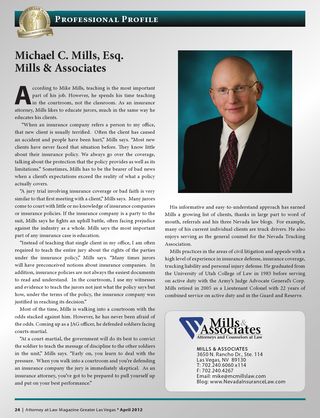Trying a case is an expensive proposition. The attorneys need to prepare the evidence, the arguments and the examinations. Clients see any opportunity to economize on the trial prep side as a positive. In the past, attorneys have made it a practice to file pre-trial motions in limine. Motions in limine are heard with the hope that the judge will make early evidentiary rulings and thereby speed up the trial. However, the Nevada Supreme Court case of BMW v. Roth, 127 Nev. Adv. Op. 11 (2011) calls into question whether the attorney should even bother to file motions in limine. Mills & Associates believes that in spite of this decision, motions in limine are still an important tool in pre-trial preparations. Please let us explain why.
Roth was rendered a paraplegic when the BMW in which she was riding rolled over and she was ejected.
Roth sued the driver for negligence and BMW for strict product liability. Roth claimed that at the time of the accident she was wearing her seatbelt and that due to a defect it failed to restrain her. BMW’s experts said Roth was not even wearing a seat belt.
One of Roths’ pre-trial motions in limine dealt with NRS 484D.495(4), Nevada’s seatbelt statute which says that failure to use a seat belt “[m]ay not be considered as negligence or as causation in any civil action or as negligent or reckless driving under NRS 484B.653.” Roth didn’t want BMW to even be allowed to say that she was not using her seatbelt. BMW countered that it must be permitted to show that Plaintiff was not wearing her seatbelt in order to defend against her allegations of a vehicle defect.
The district court granted in part and denied in part the motion. The court ruled that BMW could not argue that Roth was negligent in failing to use her seatbelt. However, BMW could introduce evidence that she was not using her seatbelt to demonstrate that the car was not defective. The trial went forward. The jury awarded Roth a $5.9 million verdict against the driver. However, the jury found that the BMW automobile was not defective.
Roth asked for a new trial. Plaintiff argued that during the trial BMW’s attorney had stepped over the line that had been drawn by the court’s order on the motions in limine. Roth claimed that during the trial BMW’s attorneys had suggested in their questions and arguments that Roth had been negligent in failing to use her seatbelt. The court granted the new trial. BMW appealed.
The Nevada Supreme Court had to decide whether the order in limine standing alone was enough to warn BMW’s attorney of where not to tread in his questions and arguments. Or alternatively, whether Roth’s attorney was obligated to object contemporaneously to the violations of the order.
The Nevada Supreme Court rejected Roth’s argument that the motion in limine constituted a continuous objection and that no contemporaneous object was necessary. Rather the Court found that an objection must be made at the time of the alleged violation of an ambiguous order in limine in order to preserve the violation for appeal.
If the violation of the order is “objected-to”, the moving party must demonstrate that the “misconduct is so extreme that objection, admonishment, and curative instruction cannot remove its effect.” Lioce v. Cohen, 124 Nev. 1, 17-18, 174 P.3d 970 (2008). On the other hand, where the violations are “not objected-to”, the appeals court will consider the issue waived unless that misconduct constitutes plain error. Id. Nev. at 19. The Court reasoned that that if the order in limine is unclear, contemporaneous objections give the trial judge an opportunity clear up any confusion as the trial moves forward. The Supreme Court found that the subject order in limine was unclear and that contemporaneous objections were needed. Because there were none, the Nevada Supreme Court ruled that the objections were waived and overturned the trial court’s grant of a new trial.
This leads us to the question that is the subject of this post. If you have to make contemporaneous
objections anyway, why bother spending the time and money preparing, filing and arguing motions in limine? The answers are simple. Motions in limine teach the judge the evidentiary issues that are in play. They give the judge the chance to better understand the reasoning and the precedent behind the arguments. Thus, it helps the judge to more appropriately rule on the question both at the time of the motion in limine and during trial.
Furthermore, filed motions in limine make a clear record of the legal arguments and issues that you could never make during the course of the trial. At a side bar before the bench, there is insufficient time to make anything other than a brief argument. Even if the court excuses the jury and gives the attorney a couple of minutes, the jurors will be cooling their heels in the hallway and chomping at the bit to get back in the box and get to work. The court is very sensitive to that fact. Furthermore, in the rush you might forget an important detail or critical citation.
So if you, the consumer of the legal services, ever asks your attorney, do we really need to spend time and money on motions in limine when you have to object at trial anyway, the answer is a definitive yes. It’s Mills & Associates advice that motions in limine are still absolutely necessary.
 Follow
Follow Email
Email


